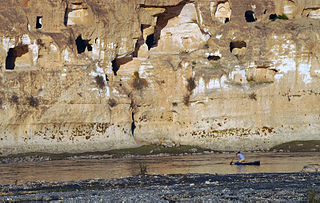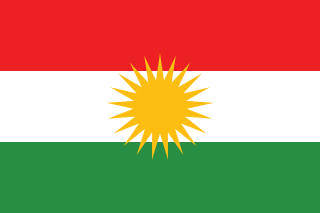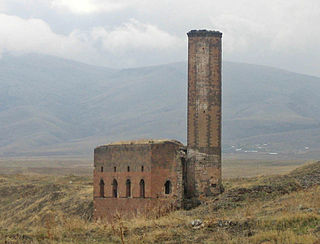 W
WThe history of Diyarbakır, one of the largest cities in southeastern Turkey and a metropolitan municipality of Turkey, spans millennia. Diyarbakır is situated on the banks of the Tigris River. The city was first mentioned by Assyrian texts as the capital of a Semitic kingdom. It was ruled by a succession of nearly every polity that controlled Upper Mesopotamia, including the Mitanni, Arameans, Assyrians, Urartu, Armenians, Achaemenid Persians, Medes, Seleucids, and Parthians. The Roman Republic gained control of the city in the first century BC, by which stage it was named "Amida". Amida was then part of the Christian Byzantine Empire until the seventh century Muslim conquest, after which a variety of Muslim polities gave way to the Ottoman Empire in the 16th century. It has been part of the Republic of Turkey since the dissolution of the Ottoman Empire in the early 20th century.
 W
WThe Kurds, are an Iranian ethnic group in the Middle East. They have historically inhabited the mountainous areas to the south of Lake Van and Lake Urmia, a geographical area collectively referred to as Kurdistan. Most Kurds speak Northern Kurdish (Kurmanji) or Sorani, which both belong to the Kurdish languages.
 W
WThe Annazid or Banu Annaz or Al-Anazis (990–1116) were a Kurdish Sunni Muslim dynasty that ruled a territory on the present-day Iran-Iraq frontier that included Kermanshah, Ilam, Hulwan, Dinawar, Sharazour, Daquq, Daskara, Bandanijin (Mandali), and No'maniya (in south-eastern Iraq). According to the Kurdish history Sherefname, the title of the dynasty was Ayyar not Annaz, therefore the alternative name Ayyarid is also used.
 W
WThe Ayyubid dynasty was a Sunni Muslim dynasty of Kurdish origin, founded by Saladin and centered in Egypt, ruling over the Levant, Mesopotamia, Hijaz, Nubia and parts of the Maghreb. The dynasty ruled large parts of the Middle East during the 12th and 13th centuries. Saladin had risen to vizier of Fatimid Egypt in 1169, before abolishing the Fatimid Caliphate in 1171. Three years later, he was proclaimed sultan following the death of his former master, the Zengid ruler Nur al-Din and established himself as the first custodian of the two holy mosques. For the next decade, the Ayyubids launched conquests throughout the region and by 1183, their domains encompassed Egypt, Syria, Upper Mesopotamia, the Hejaz, Yemen and the North African coast up to the borders of modern-day Tunisia. Most of the Crusader states including the Kingdom of Jerusalem fell to Saladin after his victory at the Battle of Hattin in 1187. However, the Crusaders regained control of Palestine's coastline in the 1190s.
 W
WKhanaqin
 W
WThe nationalist movement among the Kurdish people first emerged in the late 19th century with an uprising in 1880 led by Sheik Ubeydullah. Many Kurds worked with other opponents of the Ottoman regime within the Committee of Union and Progress (CUP). A growth in ethnic consciousness at the start of the 20th century was spearheaded by the Society for the Elevation of Kurdistan. Some Kurdish nationalist groups agitated for secession, others for autonomy.
 W
WHasankeyf Emirate was a Kurdish emirate centered around Hasankeyf and ruled by descendants of the Ayyubid dynasty until its dissolution in 1524. They considered their emirate as the last remnant of the Ayyubid state. The rulers were called melik and continued to lead the emirate from 1232 to 1524 despite invasions and different sovereigns.
 W
WEmirate of Kilis was a Kurdish emirate which ruled the Kilis and Aleppo regions up until the disintegration of the Ayyubid dynasty in 1264. The leader of Kilis had the title Mend and the main religion was Yazidism.
 W
WŞirvan Emirate was a Kurdish beylik centered around Şirvan after the fall of the Ayyubid dynasty in 1264. The founder of Şirvan was Emir Hasan who was a relative of Emir Kor of the Soran Emirate. The emirate ultimately lost its autonomy due to the Ottoman centralization policies in the mid-1840s and its Kurdish leaders were driven out. At its peak, the emirate included much of the area from Bitlis to Hakkâri including Kurtalan and its rulers were loyal to Bohtan Emirate to the south and its leader Bedir Khan Beg. Although removed from power, the descendants of the former rulers of Şirvan still commanded respect in the area towards the end of the 19th century.
 W
WThe Flag of Kurdistan, First was created by Xoybûn party during the Ararat rebellion against Turkey in 1928, where it was hoisted by thousands of Kurdish rebels. The flag was subsequently presented to the European powers at the Versailles Peace Conference. When the Republic of Mahabad in Iran was proclaimed in 1947, Mustafa Barzani hoisted the flag in Mahabad and the flag was adopted as the official flag of Kurdistan. Kurdistan Region of Iraq has since adopted the same flag as the official flag.
 W
WThe Hazaraspids (1155–1424), was a Kurdish Sunni Muslim dynasty that ruled the Zagros Mountains region of southwestern Iran, essentially in Lorestan and the adjacent parts of Fars which flourished in the later Saljuq, Ilkhanid, Muzaffarid, and Timurid periods.
 W
WThe Iran–PJAK conflict is an armed conflict between the Islamic Republic of Iran and Kurdish rebels of the Kurdistan Free Life Party (PJAK), which began in 2004 and largely ended in 2011. The group carried out numerous attacks in the Kurdistan Province of Iran and provinces of Western Iran. PJAK is closely affiliated with the militant Kurdistan Workers' Party (PKK), the primary opponent of the Republic of Turkey in the Kurdish–Turkish conflict. PJAK has been designated as a terrorist organization by Iran, Japan, Turkey, and the United States.
 W
WIraqi–Kurdish Autonomy Agreement of 1970 was an agreement, which the Iraqi government and the Kurds reached March 11, 1970, in the aftermath of the First Iraqi–Kurdish War, for the creation of an Autonomous Region, consisting of the three Kurdish governorates and other adjacent districts that have been determined by census to have a Kurdish majority. The plan also gave Kurds representation in government bodies, to be implemented in four years. For its time it was the most serious attempt to resolve the long-running Iraqi–Kurdish conflict.
 W
WThe Iraqi–Kurdish conflict consists of a series of wars and rebellions by the Kurds against the central authority of Iraq during the 20th century, which began shortly after the defeat of the Ottoman Empire in World War I and lasting until the U.S. invasion of Iraq in 2003. Some put the marking point of the conflict beginning to the attempt by Mahmud Barzanji to establish an independent Kingdom of Kurdistan, while others relate to the conflict as only the post-1961 insurrection by the Barzanis. The conflict lasted until the US invasion of Iraq in 2003, though tensions between the Kurdish autonomy and the central Iraqi government have continued.
 W
WKurdish Heritage Foundation of America, also known as Kurdish Library and Museum, was a cultural organization based in Brooklyn, New York. It collected items related to Kurdish culture, literature and history. Its library contained around 3,000 volumes on Kurdish-related subjects.
 W
WDuring World War I, several Kurdish rebellions took place within the Ottoman Empire. These revolts were encouraged by the western allies, particularly Britain, who promised the Kurds an independent state. Nonetheless, the allies provided only limited military support. British promises of an independent Kurdistan were included in the 1920 Treaty of Sèvres, which assigned a small amount of territory for a planned Kurdish state, but these plans were abandoned in 1923 with the Turkish victory in the Turkish War of Independence and the ensuing Treaty of Lausanne.
 W
WKurdish separatism in Iran or the Kurdish–Iranian conflict is an ongoing, long-running, separatist dispute between the Kurdish opposition in Western Iran and the governments of Iran, lasting since the emergence of Reza Shah Pahlavi in 1918.
 W
WKurds in Turkey refers to people born in or residing in Turkey who are of Kurdish origin. The Kurds are the largest ethnic minority in Turkey. According to various estimates, they compose between 15% and 20% of the population of Turkey. There are Kurds living in various provinces of Turkey, but they are primarily concentrated in the east and southeast of the country, within the region viewed by Kurds as Turkish Kurdistan. Officially in Eastern Anatolia and Southeastern Anatolia Regions.
 W
WKurds in Iraq are people born in or residing in Iraq who are of Kurdish origin. The Kurds are the largest ethnic minority in Iraq, comprising between 15% and 20% of the country's population according to the CIA World Factbook.
 W
WThe Mardin engagement ceremony massacre was a massacre carried out by Mehmet Çelebi, a village guard of Kurdish origin, at an engagement ceremony where at least forty-four people were killed on May 4, 2009, in the village of Bilge in the Mazıdağı district of south-eastern Mardin Province in Turkey. The attack was perpetrated using grenades and automatic weapons by at least two masked assailants, who authorities believe are involved in a feud between two families. According to some sources, it was an internal feud of the Kurdish Çelebi clan.
 W
WThe Marwanids were a Kurdish Sunni Muslim dynasty in the Diyar Bakr region of Upper Mesopotamia and Armenia, centered on the city of Amid (Diyarbakır). Other cities under their rule were Arzan, Mayyāfāriqīn, Hisn Kayfa (Hasankeyf), Khilāṭ, Manzikart, Arjish.
 W
WKurdish nationalism is a nationalist political movement which asserts that Kurds are a nation and espouses the creation of a state in Kurdistan, in opposition to the various nationalisms of the states that it is part of.
 W
WPrincipality of Eğil was a Kurdish principality or emirate around the town of Eğil founded by Pir Mansûr (b.989) who conquered the town around 1049. Pir Mansûr was a descendant of Prophet Mohammed and settled in the area from Hakkâri in 1049. The descendants of Pir Mansûr would rule Eğil for nearly eight centuries. During the rule of Emir Muhammed, the principality had expanded southward to Karaca Dağ, Palu and Elazığ northward, Çermik to the west and the area between Hani and Lice to the east.
 W
WThe Principality of Suleyman or the Principality of Qulb was the Kurdish principality that ruled the Silvan and Qulb regions from the 15th century until1838. Süleyman Bey (Silivânî) comes from the name of a Kurdish noble family and consists of the Kurdish pronunciation of the name "Süleyman", which is the name of the administrative unit, rather than the town itself.
 W
WPrincipality of Zirqan (1335-1835) was a Kurdish principality founded in the north of Mardin in 1335. During the Aq Qoyunlu period, they controlled the Bitlis, Diyarbakır and Mardin regions. Zirqan principality consists of Ataq, Tercil, Gürdükan and Mihrani regions.
 W
WRawwadid or Ravvadid or Banū Rawwād (955–1071), was a Muslim ruling family centered in historic Azerbaijan between the late 8th and early 13th centuries.
 W
WThe Shaddadids were a Kurdish Sunni Muslim dynasty who ruled in various parts of Armenia and Arran from 951 to 1199 AD. They were established in Dvin. Through their long tenure in Armenia, they often intermarried with the Bagratuni royal family of Armenia.
 W
WThe Sharafnama is the famous book of Sharaf al-Din Bitlisi (1543–1599), which he wrote in 1597, in Persian. Sharafnama is regarded as the main source on Kurdish history. It deals with the different Kurdish dynasties such as, Saladin the Great and his Ayyubid Dynasty, ancient and Medieval Kurdish principalities in the Middle-East and the Caucasus, as well as some mentioning about the pre-Islamic ancestors of the Kurds.
 W
WSoran Emirate was a medieval Kurdish emirate established before the conquest of Kurdistan by Ottoman Empire in 1514 and later revived by Emir Kor centered in Rawandiz from 1816 to 1836. Kor was ousted in an offensive by the Ottomans.
 W
WSpread of Islam among Kurds started in the 7th century with the Early Muslim conquests. Before Islam, the majority of Kurds belonged to the Zoroastrianism religion. Kurds were a nation divided between the Byzantine and Persian Empires when Islam first appeared. Jaban al-Kurdi and his son Meymun al-Kurdi were the first Kurds who converted to Islam and Halîl al-Kurdi es-Semmâni was one of the first Kurdish tabi'uns. However, mass conversion of Kurds to Islam didn't happen until the reign of Umar ibn Al-Khattab, second caliph of the Rashidun Caliphate between 634-644. Today the majority of Kurds are Sunni Muslims, and there are Alevi and Shia minorities. Sunni Muslim Kurds are mostly Shafiʽis and Hanafis.
 W
WThe Tabriz khanate was one of the Caucasian Khanates, located in historic Azerbaijan which remained semi-independent for 55 years.
 W
WThis is the timeline of the Turkish-Kurdish conflict. The Kurdish insurgency is an armed conflict between the Republic of Turkey and various Kurdish insurgent groups, which have demanded separation from Turkey to create an independent Kurdistan, or to have autonomy and greater political and cultural rights for Kurds in Turkey. The main rebel group is the Kurdistan Workers' Party or PKK, which was founded on November 27, 1978, and started a full-scale insurgency on August 15, 1984 when it declared a Kurdish uprising. Apart from some extended ceasefires, the conflict has continued to the present day.
 W
WThe Yeşilova incident was a reported armed stand off that took place at a refugee camp in Yeşilova, a small Turkish town near the border between Iraq and Turkey, between British Royal Marines and the Turkish Armed Forces. Local Turkish soldiers have been accused of stealing essential goods and preventing medical care from deprived refugees in dire conditions, with a cholera outbreak ongoing.